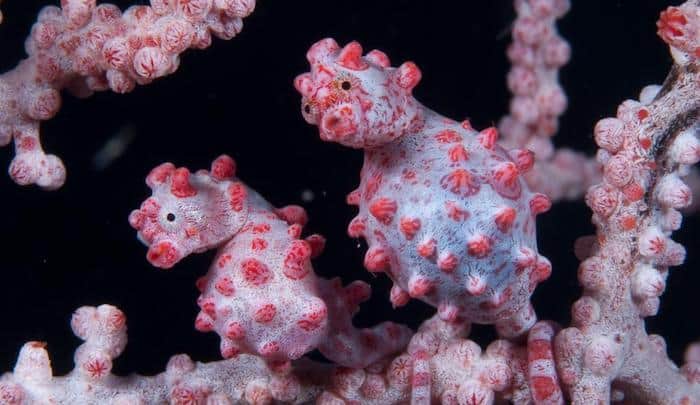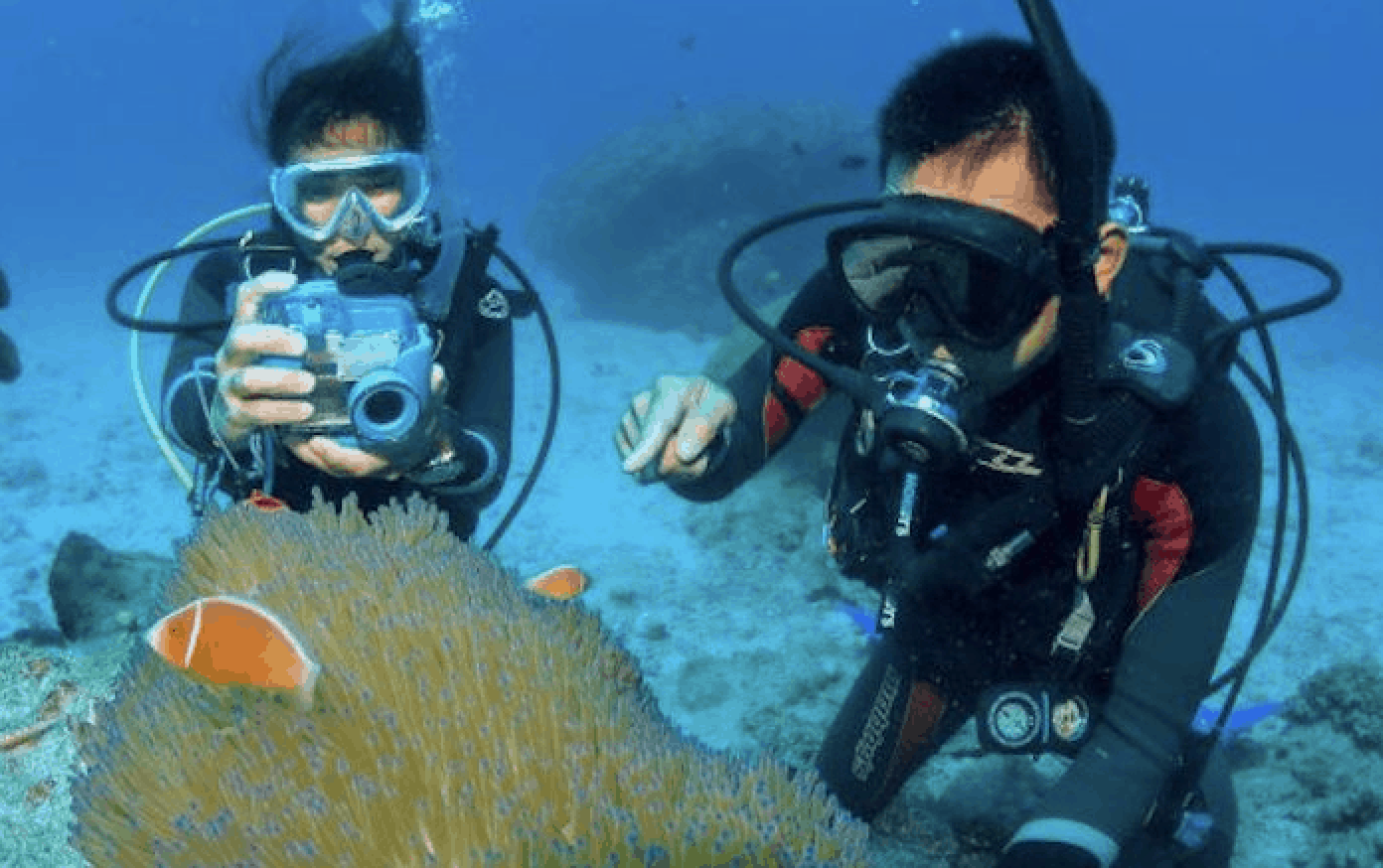Underwater photography etiquette varies the world over, according to different diving conditions and different operators individual “do’s” and “don’ts”. It can be confusing to know what is acceptable and what isn’t – especially for those who are new to taking underwater images.
Here we outline some of the basic principles of responsible underwater photography which will help you to avoid creating chaos underwater, have more enjoyable photography dives and form better relationships with your fellow divers!
DO be careful with your fins
Most underwater photographers adopt a “froggie style” fin kick as opposed to the traditional scissor kick which we are taught when we learn. The froggie kick keeps your fins more elevated and therefore less likely to stir up the bottom composition – especially in areas like the Lembeh Strait when you are diving over silty bottoms. The froggie style kick method is also adopted by cave divers for the same reason. Learning to fin backwards is also an essential skill in the event that the current pushes you closer than you intended to corals.

Using a froggie kick style with your fins up and behind you will prevent the bottom composition from being disturbed
DO be mindful of other photographers and videographers
Once you have spotted a critter and are taking pictures, or especially video, and notice that other photographers are waiting to get a shot, take just a few and move on to give others a chance before the critter gets fed up and swims away. Videographers should wait until the end as they will be with the critter for the longest period.
DO limit your number of shots of particular critters
Pygmy seahorses, for example, will turn away from the strobe lights after one or two flashes – if you didn’t get the image you were hoping for within those shots you are highly unlikely to improve on them as the pygmy will face into the fan.

Pygmy seahorses will turn into the fan after one or two strobe shots
DO secure all dangling equipment so it does not damage the reef or stir up sediment
Dangling SPG’s, alternate air sources, slates, etc should all be secured away so that they remain easily accessible for safety reasons but do not damage the reef or disturb the bottom composition as you are exploring.

Secure dangling equipment at all dive sites
DO use your neutral buoyancy techniques
Use both your BCD and breathing to maintain neutral buoyancy so you can take images without having to rest on the reef or bottom to stay stable.

Establish neutral buoyancy to avoid disturbing marine life
DO use a pointer stick to limit your bottom contact
A Pointer stick in the sand, rock or non-living part of the reef can help steady yourself without damaging the marine environment. Always check the area for any living organisms before placing your stick.
DO ask for help with buoyancy and weighting
If you are struggling with how many weights to carry; feeling underweighted or overweighted, talk to our dive guide for advice. Two Fish DIve Guides and Instructors have years of experience and are here to help.

Do not lay on the reef or sand to take pictures. Control your buoyancy instead
DO Share your critters with other underwater photographers
You will not make fast friends by getting back on the boat and boasting about the rare critters you saw if you kept them to your self and didn’t share them with others
DON’T lay on the reef or bottom composition
Aim to remain neutrally buoyant and off the bottom while taking your photos. Use a pointer stick in a neutral position to steady yourself if necessary.
DON’T “hog” critters
If you can see that other divers are waiting to take a shot don’t keep shooting until the critter turns away or retreats into hiding.
DON’T get disqualified!
There is a growing trend in underwater photography competitions whereby winning images have been disqualified as the subject has either been manipulated, moved or is clearly under threat. Judging panels are reaching out to marine biologists to check if the behaviour on display is natural and if it has been photographed in its natural environment.
These are rules taken directly from the World Shoot Out (Underwater Photography Competition):
11. Upon registering to the competition, each participant signs an environmental conservation commitment, according to which he/she are obligated to follow environmental conservation regulations and to share respect to the underwater world while shooting images or videos underwater. This applies to any participant, wherever they might be scuba diving, free diving or snorkeling. As per this commitment, the photographer understands that he/she are the only one responsible for their behavior underwater while capturing images. Any damage to the protected underwater world, including the disruption of the natural habitat of creatures, provocation through touching, feeding or annoying, is prohibited and might disqualify the images or the photographer.

Share your critter find s with your buddies – you’llencourage them to share their finds with you too
DON’T use your pointer stick to harass critters
Pointer sticks are for pointing and balance not for manipulating critters into a different position to get a better shot. Us your stick carefully and with consideration and always check the area before placing your stick on an unliving part of the reef or critter-free patch of sand.

No critters should be manipulated or interfered with in this way
DON’T move critters
There has been a recent trend in underwater photography competition entries being disqualified as the critter has clearly been manipulated – for example, photographed on a coral it would not normally reside on or in the company of another critter it would usually avoid or even in the hands of a human….
DON’T harass critters
As in the point above, competition photograph entries have been disqualified as the critter is displaying behaviour indicative of it being under threat.
Guidelines for your Dive Guide
You may see our guides use a pointer stick from time to time to encourage a critter into an easier position for you to shoot but this depends very much on the critter and it’s the environment.
- Please remember that many of our Dive Guides have been diving for decades and they are experts on the marine life and it’s behavioral habits. They understand from a biological point of view which critters require careful attention and those which should never be interfered with, which is especially important in the critter capital of Two Fish Lembeh.
- Please trust that they understand what can and should not be done for the protection of our marine life.
- Please do not ask our dive guides to manipulate marine life as their first and foremost desire is to protect and conserve our extraordinary species for generations to come.
If you follow these simple guidelines, you and your buddies will return home with images and memories that will last a lifetime and you’ll actively be conserving and protecting the marine life of Indonesia – thank you!
Want to Dive and Save?
Check out our Special Offers Page and find out what discounts and promo’s are currently available at our Two Fish Dive Centers across Indonesia!
Ready to Book with us?
If you’d like to find out more about diving with us and especially our underwater photography facilities at Two Fish Lembeh, please fill in the contact form below and we will get right back to you. If you are claiming a special offer discount, be sure to mention it in your comments!







